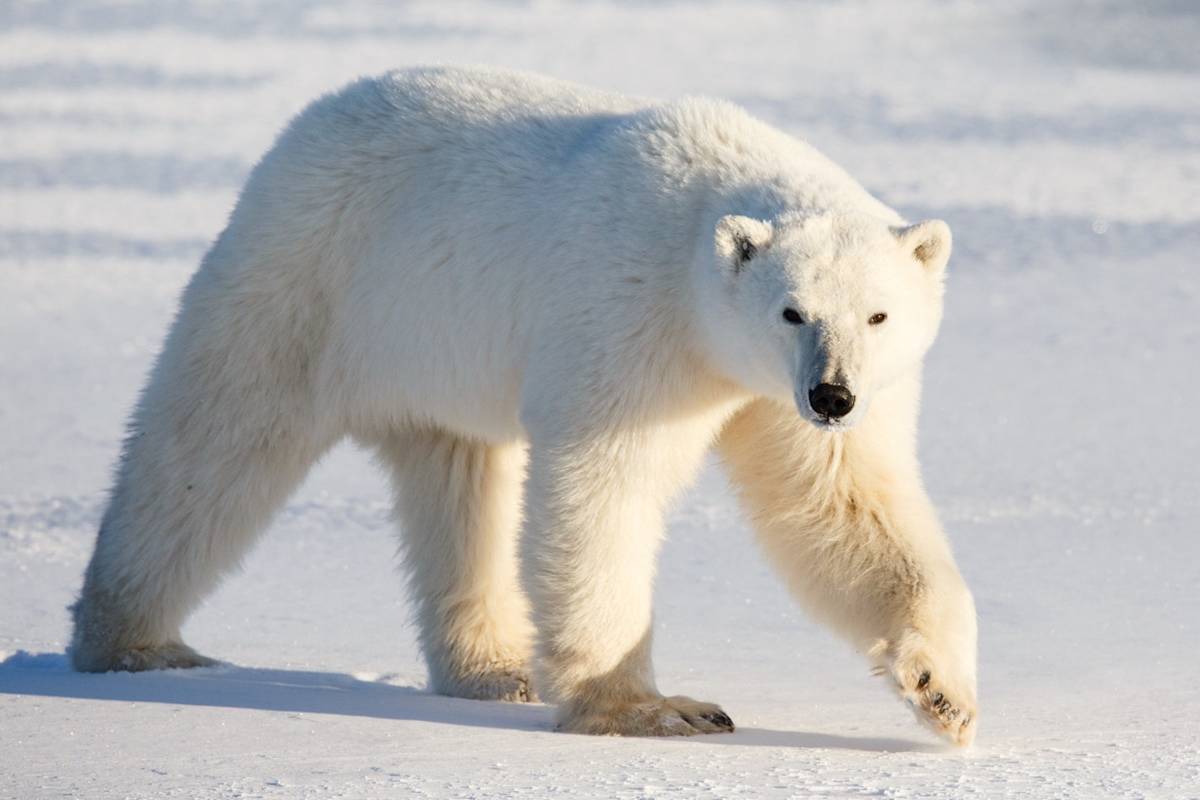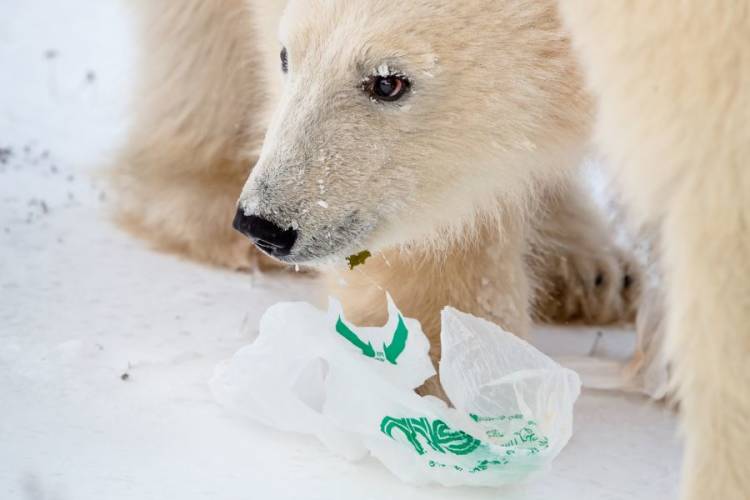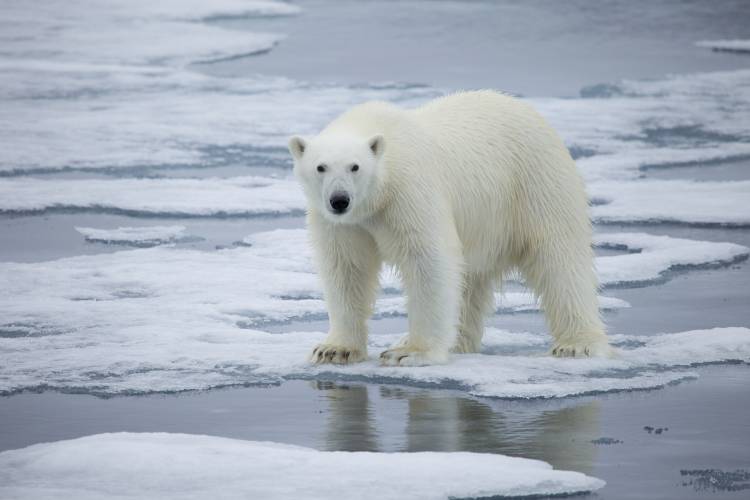
Photo: Craig Taylor / Polar Bears International
Do Polar Bears Undergo Walking Hibernation?
By Dr. Thea Bechshoft, Staff Scientist
MINS
26 Aug 2019
We’re back with our polar bear questions series, this time with a question from Julia: “I’ve heard that polar bears have a summer/early fall energy-saving mode called ‘walking hibernation,’ but I see little recent info about it on the internet. What does the research say?”
A: Ah, yes, walking hibernation. Excellent question, Julia, and one that I’m afraid requires a bit of a lengthy answer! I’ve been asked about this phenomenon quite frequently recently, so here we go:
A brief introduction
Many polar bears around the Arctic have to live off their body’s fat reserves during the summer and before fall freeze-up, where there is little or no sea ice and thus no access to seals. The fatter the bear, the better its chances of surviving the summer and being healthy and ready to hunt again once the sea ice returns in the late fall. While on land, the bears are largely starving, losing around one kilogram per day. They may eat berries, eggs, or kelp while they’re waiting, but, unfortunately, none of these terrestrial summer foods are fatty or abundant enough to sustain them long-term.
Polar bears don’t really hibernate
Only pregnant polar bear females enter a den for months at a time (October-March); they give birth to their cubs there and nurse them for the first three months of their lives. All other polar bears are outside during the winter, hunting seals and going about their everyday business. While in the den, the female may lower her heart rate, her metabolism, and breathing rate, but never to the point that we see in the “deep” (or true) hibernators such as some rodents and bats. She is instead in a state of “light hibernation,” which allows her to minimize the amount of energy needed to stay alive, while also being able to tend to her cubs.
Walking hibernation
In the early 1980s, a group of researchers started wondering whether polar bears could perhaps enter this state of “light hibernation” during the lean summer months, thereby saving energy while still being able to be moderately active. They called this altered physiological state “walking hibernation,” something that was already thought to exist in black and grizzly bears for the first few weeks after they left their winter den. This physiological state was characterized by a change in the ratio of two specific compounds in the blood called urea and creatinine; when the concentration of urea decreases, it indicates that the bear is not eating, but instead living off its own fat reserves. Meanwhile, creatinine is stable regardless of whether the bear is eating or not.
In 1983, these researchers published a scientific paper in which they showed that blood samples from polar bear females coming out of the den was similar to that of newly-emerged black and grizzly bears (see list of the various papers below). Also, it appeared that polar bears could go in and out of this state of “walking hibernation” with little difficulty, depending on whether they were fasting or not. This was supported by a couple of other studies published in the early 1990s: When polar bears were feeding, the ratio went up; when they weren’t feeding, the ratio dropped. Changing between the two states took about half a week to a whole week.
A later study, published in 2008, measured the ratio in polar bears in the Beaufort Sea, one of the Arctic areas that has seen the biggest climate-change-induced reduction in sea ice. The researchers found that the number of polar bears in this population that were in a fasting state ("walking hibernation") during the spring months had increased as the sea ice conditions were getting worse, from 10% in 1985 to 29% in 2006. In other words, everything pointed toward the fact that polar bears were able to slow down their metabolism by going in and out of “walking hibernation,” which helped them maintain their body weight during the lean summer period.
No miracle cure
A number of later studies found that fasting polar bears were still losing weight—an average of one kilogram per day, regardless of whether or not “walking hibernation” was a fact. A 2012 paper found that the energy cost during periods of fasting was still larger than for hibernating bears; staying active during cold winters or during the ice-free summer periods has a very high cost.
Another paper, published in 2015, described a Beaufort Sea project in which researchers implanted temperature loggers in a number of wild polar bears. Using the body core temperature as a measure of metabolic activity (the more the bear was eating, the higher the active metabolism and the higher the temperature), the research team found no sudden temperature changes, which would have otherwise hinted at a bear entering the suggested state of “walking hibernation.” Instead, they found only gradual, moderate declines in body temperature of the bears over the summer period, similar to the energy use typical of fasting, non-hibernating mammals. In other words, there was no indication whatsoever that these polar bears were able to significantly adjust their metabolism to deal with a scarcity of prey.
So, what’s the conclusion?
I think the conclusion is best summarized in the 2012 paper: “…we recommend that the term ‘walking hibernation’ not be used to describe summer–fall fasting in polar bears as it implies greater energy conservation than actually occurs.”
It would be great to have a polar bear study that examined the blood urea/creatinine ratio as well as body weight, as this would allow a deeper understanding of the physiological dynamics happening inside a starving bear. However, all evidence points to the fact that polar bears possess no special trick to help them survive lengthy periods without food. Instead, they lose weight just like any other starving mammal. To survive long-term, polar bears need a good platform of sea ice from which to hunt seals. In short: no sea ice = no polar bears.
Dr. Thea Bechshoft is a polar bear scientist based in Aarhus, Denmark, and part of the Polar Bears International team. She is the author of the popular Polar Bear Questions page on Facebook, republished here with permission.
Papers cited
Derocher, A.E., Stirling, I. & Ramsay, M.A. 1990. Effects of fasting and feeding on serum urea and serum creatinine levels in polar bears. Marine Mammal Science, 6, 196-203.
Nelson, R.A., Folk, G.E., Pfeiffer, E.W., Craighead, J. J., Jonkel, C. J. & Steiger, D.L. 1983. Behavior, biochemistry, and hibernation in black, grizzly, and polar bears, Bears: Their Biology and Management, 5, 284-290.
Ramsay, M. A., Nelson, R. A. & Stirling, I. 1991. Seasonal changes in the ratio of serum urea to creatinine in feeding and fasting polar bears. Canadian Journal of Zoology, 69, 298-302.
Robbins, C.T., Lopez-Alfaro, C., Rode, K. D., Toin, O. & Nelson, O. L. 2012. Hibernation and seasonal fasting in bears: the energetic costs and consequences for polar bears. Journal of Mammalogy, 93, 1493-1503.
Whiteman, J. P., Harlow, H. J., Durner, G. M., Anderson-Sprecher, R., Albeke, S. E., Regehr, E. V., Amstrup, S. C. & Ben-David, M. 2015. Summer declines in activity and body temperature offer polar bears limited energy savings. Science, 349, 4.














